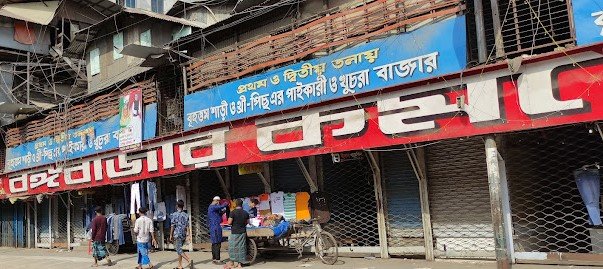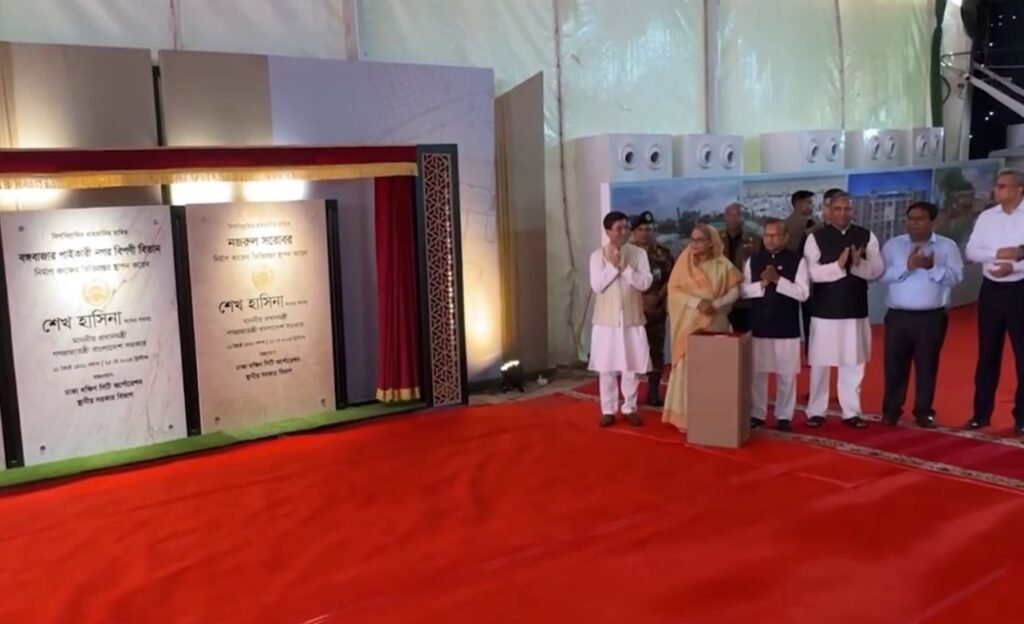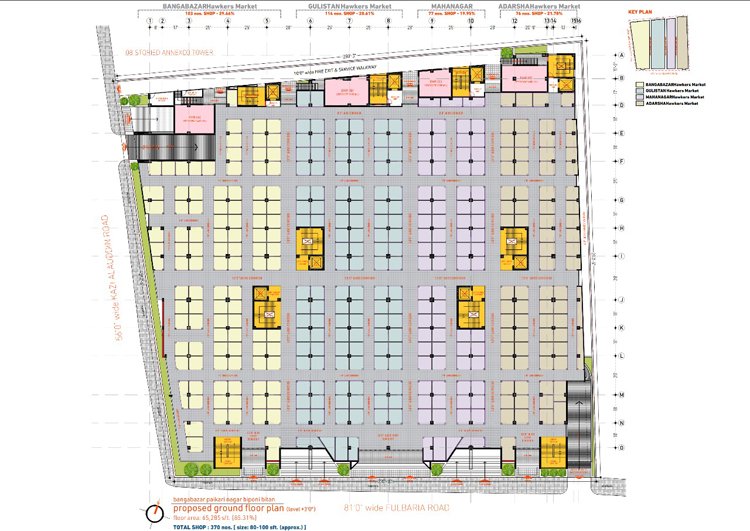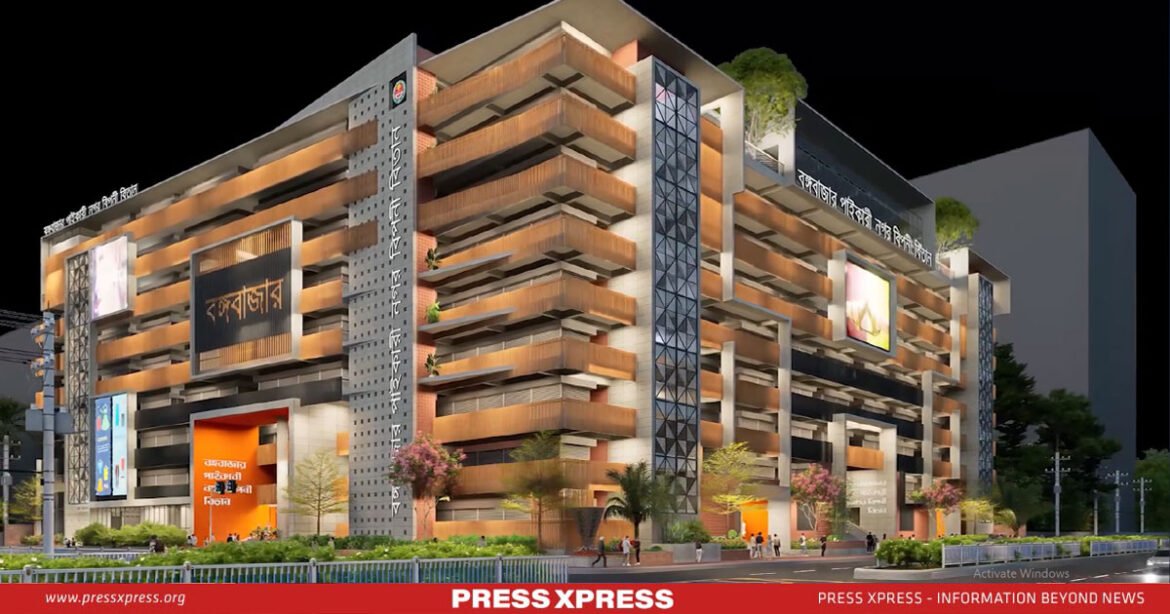- New market will have 3,215 shops
- Total cost of construction will be Tk365 crore
The construction of the 10th floor of the Bangabazar Wholesale City Market, overseen by the Dhaka South City Corporation (DSCC), began on Saturday, May 25. Prime Minister Sheikh Hasina inaugurated the construction work.
On April 4, 2023, a devastating fire destroyed over 2,931 cloth shops, impacting thousands of traders’ livelihoods just weeks before Eid. In response to the disaster, the Prime Minister pledged to build a new multi-storey building.
You Can Also Read: FIRE AT BANGABAZAR CLOTHING MARKET
The new market will feature a 10-storey structure on 106.28 khata of land, comprising four blocks, five common staircases, six emergency staircases, and 3,213 shops, each ranging from 80 to 110 square feet.
Overview of Bangabazar Wholesale Market
Before the inauguration of Kamalapur Railway Station on May 1, 1968, Dhaka’s primary railway station was located in Fulbaria, adjacent to Gulistan. In 1965, a market developed around the station, bustling with hawkers and vendors who carried headloads of goods daily. They sold snacks, drinks, souvenirs, and everyday items. This marked the humble beginnings of Bangabazar, which would later evolve into the country’s largest wholesale and retail market for readymade garments.
Despite the old railway station’s closure, Bangabazar thrived, becoming a hub at the intersection of several busy roads. However, during its time under the supervision of Dhaka Improvement Trust (DIT), hawkers had ulterior motives—they aimed to occupy the space permanently. Consequently, they erected illegal temporary tin sheds.
In 1975, the Dhaka municipal administration decided to demolish these tin sheds and construct a proper market building. Yet, this task posed challenges. The land on which Bangabazar stood belonged to the railway authorities, who hesitated to transfer ownership. Eventually, an agreement was reached: shop owners would lease portions of the land annually, allowing them to run their businesses legally.
A Great Leap Forward
In 1985, the area was formally transferred to the Dhaka City Corporation (DCC). By 1989, the corporation had completed the construction of the planned shopping centre. Bangabazar, which had humble beginnings, emerged as a thriving hub for readymade garments by 1990. It seamlessly integrated with three other markets, covering a total land area of 21,250 square feet.
Bangabazar now comprises four units: the Bangabazar Shopping Complex, along with the Gulistan, Mahanagari, and Adarsha units, collectively housing approximately 5,000 shops. Interestingly, despite concrete pillars on the ground floor, the entire complex was constructed using tin and wood.

In addition to readymade garments like shirts, pants, trousers, t-shirts, jackets, and hosiery, Bangabazar offers salwar-kameez, sarees, and footwear—both wholesale and retail. The market caters not only to fresh items but also provides second-hand goods and factory overruns at exceptionally affordable prices. Its appeal extends beyond local consumers and traders, attracting buyers from India, Nepal, Bhutan, Iran, and Russia.
While business remains steady throughout the year, it experiences a surge during the winter season. However, the pinnacle of activity occurs during Ramadan, accounting for nearly 70% of the market’s annual sales.
Safety Issues Remained Unsolved
Despite being a favorite shopping destination, Bangabazar gained global notoriety for all the wrong reasons. In 1995, a mere five years after establishing itself as the wholesale and retail hub for readymade garments, disaster struck. A devastating fire razed Bangabazar to the ground, reducing 2,200 shops to ashes and leaving countless shop owners destitute. The estimated loss from the fire amounted to several crores of taka.
To rebuild the market, the government contributed Tk1 crore, and the Dhaka City Corporation (DCC) added Tk40 lakh. Additionally, each shop owner contributed Tk 5,000. However, the challenges persisted. On July 24, 2018, another fire erupted in the Gulistan unit of Bangabazar, damaging several shops.
In 2017, an observatory committee from the Fire Service and Civil Defence labeled all four units of Bangabazar as ‘extremely risky’. Despite serving notices and recommending safety measures within 30 days, their warnings went unheeded. The fire extinguishing system was deemed perilous during a subsequent inspection in December 2018.
Following the 2018 fire, the Fire Service and Civil Defence issued additional warnings to the market authorities. A signboard declaring the Bangabazar area and surrounding buildings as fire hazards was erected on April 1, 2019, but it was later removed.
The market’s wooden construction posed a significant challenge—relying solely on fire extinguishers would be insufficient in an emergency. Despite receiving official notices at least ten times, neither the market authorities nor the shop owners took adequate precautions. Surprisingly, the Dhaka South City Corporation refrained from taking substantial action against them.
From Devastation to Formation
In the wake of a catastrophic fire that engulfed 5,000 shops across four markets, Bangabazar faced immense adversity. Dreams shattered, traders left in despair, and employees lost their livelihoods.
However, hope emerged as the Dhaka South City Corporation (DSCC) embarked on a revitalization plan. Their vision? To construct a 10-storey multi-storied market on the scorched grounds of Bangabazar.

On May 25, Prime Minister Sheikh Hasina inaugurated the construction of the ambitious project—Bangabazar Nagar Wholesale Market, also known as ‘Bangabazar Paikari Nagar Bipanibitan’.
This market will occupy 106.28 katha of land, with construction costs totaling Tk365 crores, borne collectively by shop owners. The impressive structure will comprise four blocks, five general stairways, and six emergency stairways. Within its walls, 3,213 shops will thrive, ranging from 80 to 110 square feet each.

Each floor will house a 250-square-foot food court and separate toilet facilities. The market’s convenience extends beyond its interior: eight lifts—four for passengers and four for goods—will facilitate movement. Meanwhile, the roads surrounding the market will be 7 to 10 feet wide, ensuring easy access.
The building boasts an efficient firefighting system and underground parking accommodates 169 cars and 109 motorcycles. From devastation to transformation, Bangabazar is poised for a remarkable comeback.
The journey of Bangabazar from its humble beginnings to facing devastating fires and now witnessing a remarkable transformation symbolizes resilience and determination. With the initiation of the ambitious Bangabazar Paikari Nagar Bipanibitan project, hope is reignited for the revival of this iconic market. Through prioritizing safety, expanding infrastructure, and supporting affected traders, Bangabazar is poised for a vibrant comeback, showcasing the indomitable spirit of its community and the commitment to a brighter future.


